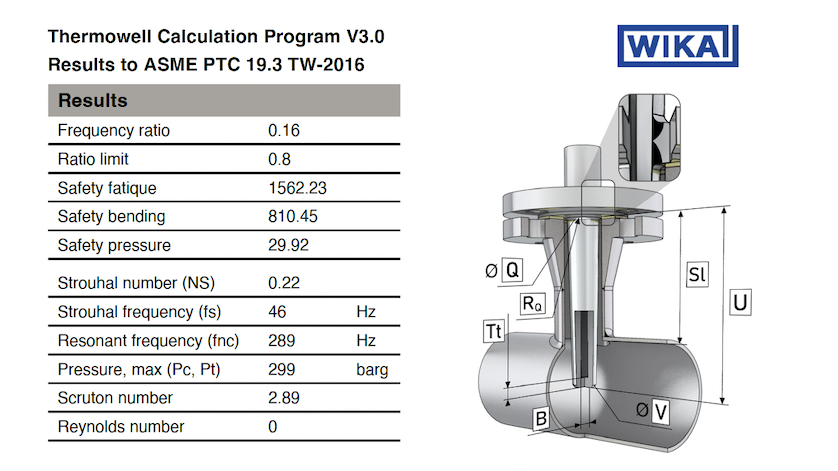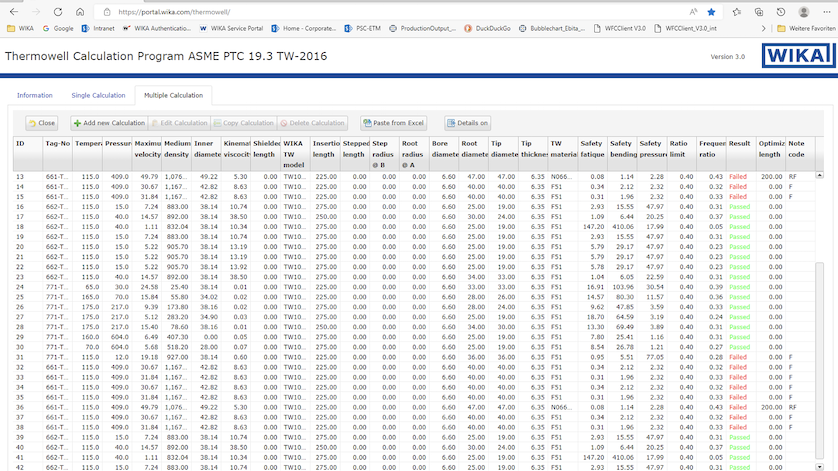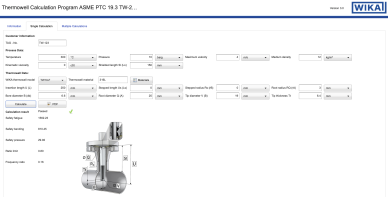
Two wake frequency calculators – a pared-down one and a full version – are free, easy-to-use online tools for determining the diameters, length, thickness, and material of a thermowell.
Thermowells are important accessories that shield sensitive temperature sensors from abrasive or corrosive process media, high pressure, and other adverse conditions that would damage the thermocouple, dial thermometer, or resistance thermometer (RTD). Because these protection devices are installed in pipelines, where the process media could flow at a fast velocity, the stems must have the correct length, root diameter, and tip diameter to prevent the formation of wake-induced vortices that create vibrations and cause mechanical fatigue.
The Importance of Wake Frequency Calculations
Sensor manufacturers offer wake frequency calculators (WFC) to help customers determine the ideal dimensions and other requirements of thermowells for specific applications. Each calculator is slightly different, but in general this tool asks the user to input information about the process (pressure, density, velocity, etc.) and the thermowell (insertion length, material, diameters, etc.). Using this data, the software then determines whether that thermowell is suitable for those process conditions.
The goal is to design a thermowell that will not suffer damage in a particular application. If the specifications fail the calculations for safety, the user can fine-tune the dimensions, stem style, and more until the results are within acceptable limits.
WIKA’s Wake Frequency Calculator
For more than two decades, WIKA’s WFC was based on VBA macros in Excel. Thousands of our customers worldwide used this tool to design their thermowells, and each new version of this program added functionalities.
VBA-based applications worked well for many years. But then issues began to crop up, such as growing incompatibility with newer versions of Windows and many companies’ concern over the security of third-party software. In short, it was time for an update.
WIKA engineers and programmers have created an online solution with all the attributes of the original Excel version, but with several additional features and the convenience of a browser-based app. Our free web-based wake frequency calculator for laptops and desktop computers is easy to use yet powerful, and comes in two variations.
Single calculation
The simplified yet fully functional version calculates the suitability of a single thermowell according to ASME PTC 19.3 TW-2016. After entering the requested data for the process and thermowell, click the “Calculate” button to see all the most important results. (The information displayed is exactly the same as in the old Excel version.) The dynamic results comprise the frequency ratio as well as the safety factor for flexural fatigue stress, while the static results are the safety factors for bending stress and the pressure load on the thermowell.
The thermowell is also depicted as a 3D rendering with all the proposed dimensions. To save and share the results, simply click on the “PDF” button to download it. The one-page PDF also includes results not shown on the webpage, such as Strouhal number, Strouhal and resonant frequencies, maximum permissible pressure load, Scruton number, and Reynolds number. Note that this simplified calculator offers the most common materials and calculation results.
Multiple calculations
The full version of the software has the same algorithm and features as the simplified version, but allows users to calculate an almost limitless number of thermowells. Here are the steps:
- Register and verify the account.
- Enter thermowell data directly in the webpage calculation form, or use a spreadsheet with all the requested process data and thermowell data in the same order as the online calculator. If using a spreadsheet, copy the data then paste it into the online calculator.
- Calculations are carried out automatically upon input, and displayed in a table with “passed” or “failed” and all the data and calculations.
- The calculations are stored in the user‘s account, with the choices of generating a PDF for each thermowell or exporting the entire table as an Excel file.

Wake frequency calculator, multiple calculations
Powerful features
The full version of the WFC is filled with options:
- All stem designs within the scope of ASME PTC 19.3 TW-2016 (tapered, straight, stepped) can be calculated in combination with any type of process connection (flanged, threaded, welded, Vanstone).
- Users can select either metric or imperial units, or a mixture of the two.
- In the database are more than 60 materials with stored data in accordance with ASME BPVC Section II Part D, and we are adding more upon request. Like the single-calculation version, users can select the material based on its ASTM designation, UNS number, DIN number, or standard international designation.
- The hover (mouseover) function displays helpful information, such as explanatory text and detailed description of software features.
- When any input values are outside the ASME PTC 19.3 design specifications, they appear on a shaded background.
- In the event a thermowell calculation fails the thresholds for safety, the program provides a note code and recommends an optimized insertion length. Users can then modify that thermowell’s specs and perform another calculation.
WIKA, Smart in Sensing
With so many variables and options, choosing and designing thermowells can be a daunting process. Contact the temperature specialists at WIKA USA for expert assistance in getting the right temperature sensors and thermowells for your unique industrial applications.


